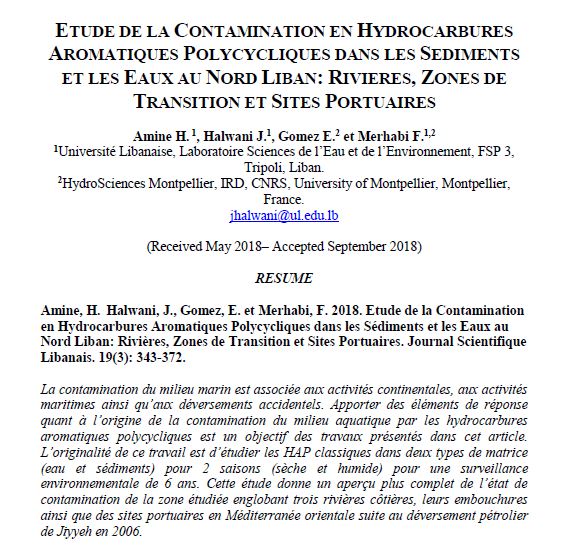Study of polycyclic aromatic hydrocarbon contamination in sediments and waters in Northern Lebanon: Rivers, transition zones and port sites
 |
Etude de la contamination en hydrocarbures aromatiques polycycliques dans les sédiments et les eaux du Liban Nord: Rivières, zones de transition et sites portuaires
thèse Sep 2018 ; 30 pages
Aut. Jalal Halwani
Ed. LU - Beirut
Téléchargeable sous format: PdF
Résumé:
La contamination du milieu marin est associée aux activités continentales, aux activités maritimes ainsi qu’aux déversements accidentels. Apporter des éléments de réponse quant à l’origine de la contamination du milieu aquatique par les hydrocarbures aromatiques polycycliques est un objectif des travaux présentés dans cet article. L’originalité de ce travail est d’étudier les HAP classiques dans deux types de matrice (eau et sédiments) pour 2 saisons (sèche et humide) pour une surveillance environnementale de 6 ans. Cette étude donne un aperçu plus complet de l’état de contamination de la zone étudiée englobant trois rivières côtières, leurs embouchures ainsi que des sites portuaires en Méditerranée orientale suite au déversement pétrolier de Jiyyeh en 2006.
Les concentrations en HAP sont exprimées comme étant la somme des 16 HAP prioritaires préconisés par l’Agence Américaine de Protection de l’Environnement (US-EPA). Une contamination globale a été notée pour tous les sites analysés. Les déversements de pétrole semblent être l'une des principales sources de pollution dans la région, les niveaux les plus élevés de HAP (> 9 000 ng.g-1 p.s et > 8 000 ng.L-1) ayant été signalés dans l'environnement côtier des trois rivières et les ports.
En comparant les concentrations des HAP mesurées dans les sédiments des sites analysés avec les critères empiriques de qualité des sédiments (Sediment Quality Guidelines "SQG") pour l’aide à l'évaluation générale de la toxicité des sédiments, nous pouvons constater que certains HAP individuels ainsi que leur somme peuvent présenter un risque écotoxicologique important pour les organismes aquatiques. Un programme de biosurveillance et d'essais d’écotoxicité seront nécessaires, car l'exposition des organismes aquatiques résidents et de la population humaine à ces produits chimiques pourrait augmenter au fil des années. Abstract:
Contamination of the marine environment is associated with continental activities, marine activities and accidental spills. Providing answers to the origin of the contamination of the aquatic environment by PAHs is an objective of the present work. The originality of this work is to study pollutants in two types of matrix (water and sediments) during 2 seasons (dry and wet) for an environmental monitoring of 6 years. This study provides a more complete overview of the state of contamination in three coastal rivers, their transition zones and harbors in the Eastern Mediterranean following the Jiyyeh oil spill in 2006.
following the Jiyyeh oil spill in 2006. Contaminants concentrations were expressed as the sum of the 16 PAHs classified as prority substances by the United States Environmental Protection Agency (US-EPA). Overall, contamination was noted for all the analyzed sites. Oil spill seem to be one of the main sources of pollution in the area, as the highest levels of PAH (> 9 000 ng.g-1 s.w & > 8 000 ng.L-1) were reported in the coastal environment of the three rivers and harbors. High levels of PAHs were also observed in rivers transitional zones, revealing the importance of terrestrial inputs (untreated wastewater discharge, leachate, solid wastes, etc.).
Comparing the PAHs concentrations measured in the sediments of the sites analyzed with the empirical sediment quality criteria "SQG" for the support of the general assessment of sediment toxicity, we can notice that some individual PAH and their sum can present a significant ecotoxicological risk to aquatic organisms. Further research through monitoring campaigns and toxicity tests is encouraged, as the exposure of the resident aquatic organisms and human population to these chemicals might be expected to increase over the years.
Publics-Cibles:
Tout public , Décideurs locaux ou nationaux , Santé (professionnels de la)
Mots clefs: |
eau de surface: rivière, lac (CI) (DT) (OP) (ope) , pollution de l'eau (CI) (DT) (OP) (ope) , qualité des eaux (CI) (DT) (OP) (ope) , recherche scientifique (CI) (DT) (OP) (ope) |
Pays concerné: |
Editeur/Diffuseur: |
|
LU
-
Université Libanaise - Beirut - Liban |
En cas de lien brisé, nous le mentionner à communication@pseau.org